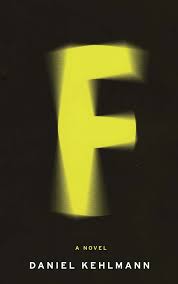“Fate,” says the writer Arthur Friedland, the unifying character of Daniel Kehlmann’s new novel F:
“The capital letter F. But chance is a powerful force, and suddenly you acquire a Fate that was never assigned to you. Some kind of accidental fate. It happens in a flash.”
F, translated by Carol Brown Janeway, is a novel about how much control we have over our lives. Its characters, in particular Arthur’s three sons, Ivan, Eric and Martin, all look to place their faith in something that will give their lives direction and meaning only to find themselves guilty of falsifying that meaning. Martin becomes a priest who does not believe in God; Ivan dedicates his life to art only to use his talent as a forger; and Eric enters the world of finance, sustaining his investment company through deception and fraud. The F of the title, however, stands for none of these things – fate, faith, forgery or fraud (none of which begin with f in German) – but family, as Kehlmann has explained:
“’Family’ is quite a big word, so in the case of my novel only the first letter remained. When I started out I thought: ‘I want to do to the family novel something similar to what I did to the historical novel when I wrote Measuring the World. Which is to write an unusual specimen of the form. A family novel for people who don’t trust family novels.”
For this reason perhaps, it’s a family novel in which the members of the family are rarely together. Only in the first chapter, a family trip on which Arthur takes his three sons to see a hypnotist, do they seem at all united. Despite his protests that hypnotism will not work on him, Arthur is led to the stage. He answers Lindeman, the hypnotist, honestly – he’s a writer whose work is largely unpublished living off his wife’s money. “Maybe ambition would be an improvement,” Lindeman tells him, “Starting today you’re going to make an effort. No matter what it costs.” Arthur is still dismissive of the hypnotist as they leave, but when he drops Martin off at his mother’s, he also leaves Eric and Ivan (he has remarried). He drives off and his sons do not see him again until they are adults.
The novel, too, travels forward in time. We learn that Martin has become a priest but that he has yet to find faith – instead he overeats and continues to enter Rubik’s Cube championships, a toy his father gave him. Eric, an investment banker, has been using his clients’ money to make it appear as if their investments have been successful but now has nothing left and knows it’s only a matter of time before he is found out. The pressure, and a steady supply of prescription drugs, mean he now has an uncertain relationship with reality:
“Stay calm. Always calm. I look up, there he is, sitting in front of me. Martin. My brother. I look at the phone, the message is still there. I look at his face. Is it my imagination after all? Am I sitting here alone?”
Ivan, having decided that his own artistic talent didn’t stretch to genius, is forging paintings for the artist’s estate which he administers. Kehlmann connects the narratives using events like the lunch which Eric and Martin share (we see it from both brothers point of view) and characters such as the boy in the Bubbletea is not a drink I like t-shirt. He also includes a chapter called ‘Family’, purportedly written by Arthur, which traces his family back over generations in a way that makes life seem bleak and meaningless.
Novels by their very nature, however, imply fate rather than chance, subject as they are to the author’s plan. Kehlmann makes no attempt to disguise this, creating a puzzle of interconnecting parts which the reader must twist and turn, like the Rubik’s Cube which Martin cannot leave behind in his childhood, until the pattern is plain. A further clue is given when Marie, Arthur’s granddaughter, looks closely at a painting by Ivan:
“She stepped even closer, and immediately everything dissolved. There were no more little people, no more little flags, no anchor, no bent watch…
She stepped back and it all came together again.”
Is Kehlmann suggesting life is meaningless when viewed from close up, but subject to pattern when the proper perspective is taken? Or is that a property only of art? Is the novel’s form in conflict with its meaning? Is its comic tone at odds with its bleak message, a question once asked of Arthur’s first novel:
“Is My Name is No One a merry experiment and thus the pure product of a playful mind, or is it a malevolent attack on the soul of every person who reads it?”
Rarely does a novel so easily read, ask the reader such difficult questions.
